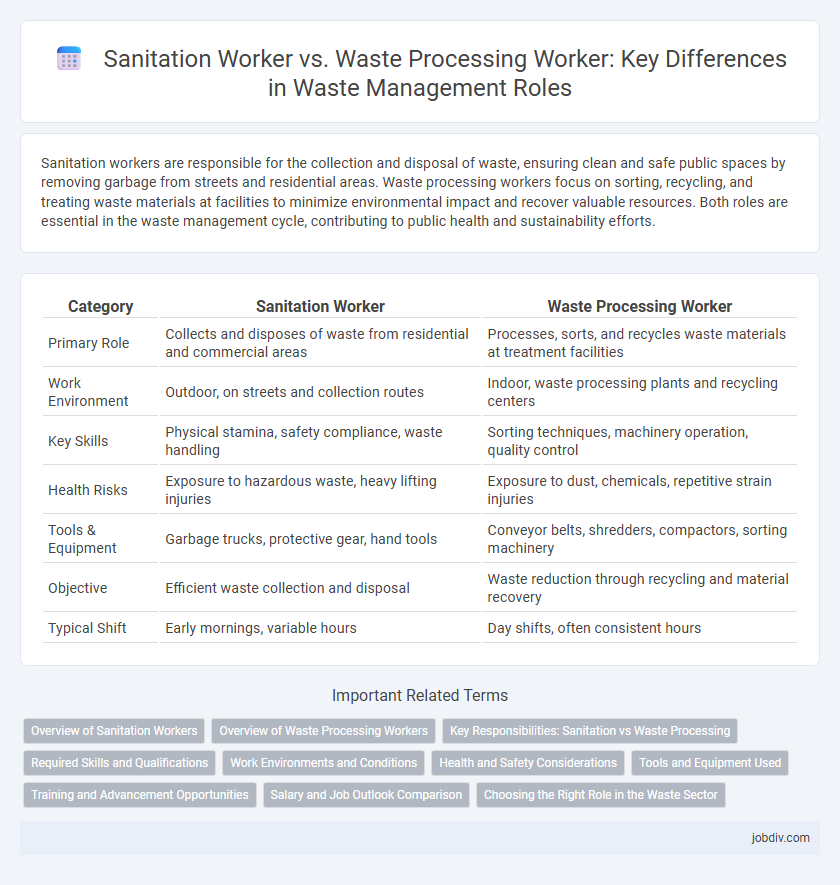Sanitation workers are responsible for the collection and disposal of waste, ensuring clean and safe public spaces by removing garbage from streets and residential areas. Waste processing workers focus on sorting, recycling, and treating waste materials at facilities to minimize environmental impact and recover valuable resources. Both roles are essential in the waste management cycle, contributing to public health and sustainability efforts.
Table of Comparison
| Category | Sanitation Worker | Waste Processing Worker |
|---|---|---|
| Primary Role | Collects and disposes of waste from residential and commercial areas | Processes, sorts, and recycles waste materials at treatment facilities |
| Work Environment | Outdoor, on streets and collection routes | Indoor, waste processing plants and recycling centers |
| Key Skills | Physical stamina, safety compliance, waste handling | Sorting techniques, machinery operation, quality control |
| Health Risks | Exposure to hazardous waste, heavy lifting injuries | Exposure to dust, chemicals, repetitive strain injuries |
| Tools & Equipment | Garbage trucks, protective gear, hand tools | Conveyor belts, shredders, compactors, sorting machinery |
| Objective | Efficient waste collection and disposal | Waste reduction through recycling and material recovery |
| Typical Shift | Early mornings, variable hours | Day shifts, often consistent hours |
Overview of Sanitation Workers
Sanitation workers play a crucial role in maintaining public health by collecting and disposing of waste from residential, commercial, and industrial areas. Their responsibilities include operating garbage trucks, performing street cleaning, and ensuring hazardous materials are handled safely to prevent environmental contamination. Unlike waste processing workers who focus on sorting, recycling, and transforming waste into reusable materials, sanitation workers primarily manage the initial stages of waste removal and containment.
Overview of Waste Processing Workers
Waste processing workers manage the sorting, treatment, and recycling of solid waste materials to reduce landfill use and environmental impact. They operate machinery and implement procedures that convert waste into reusable resources, including compost, metals, and plastics. Their role is critical in optimizing waste recovery systems and supporting sustainable waste management practices.
Key Responsibilities: Sanitation vs Waste Processing
Sanitation workers primarily focus on the collection, removal, and safe disposal of waste from residential, commercial, and public areas to maintain hygiene and prevent disease. Waste processing workers handle the sorting, treatment, recycling, and conversion of collected waste materials into reusable resources or environmentally safe byproducts. Both roles are essential for effective waste management, with sanitation workers ensuring waste removal and waste processing workers facilitating waste transformation and resource recovery.
Required Skills and Qualifications
Sanitation workers require physical stamina, knowledge of waste collection methods, and adherence to safety protocols, often needing a high school diploma and on-the-job training. Waste processing workers must have technical skills to operate machinery, understand waste sorting and recycling processes, and typically hold specialized certifications or vocational training. Both roles demand commitment to environmental health standards and teamwork, but waste processing workers generally require more technical expertise.
Work Environments and Conditions
Sanitation workers typically perform tasks in outdoor environments such as streets and residential areas, often facing physical labor under varying weather conditions and exposure to waste materials. Waste processing workers operate primarily within controlled industrial or facility settings, where they manage sorting, recycling, and treatment processes, often using machinery and protective equipment. Both roles require adherence to safety protocols, but sanitation workers encounter more direct exposure to environmental hazards, while waste processing workers deal more with operational and mechanical risks.
Health and Safety Considerations
Sanitation workers face significant health risks from exposure to hazardous waste, sharp objects, and biohazards during collection and disposal, requiring strict use of personal protective equipment (PPE) and vaccination against diseases like hepatitis. Waste processing workers encounter chemical fumes, dust, and heavy machinery hazards in recycling plants or treatment facilities, necessitating ventilation systems and regular safety training. Both roles demand rigorous adherence to occupational safety protocols to minimize injury and long-term health effects.
Tools and Equipment Used
Sanitation workers primarily use tools such as garbage trucks, trash bins, hand-operated carts, and protective gear including gloves and high-visibility clothing to collect and transport waste safely. Waste processing workers rely on advanced equipment like shredders, compactors, conveyor belts, and sorting machines to break down, separate, and recycle materials efficiently. Both roles require specialized machinery tailored to their specific stages in the waste management cycle, optimizing safety and operational effectiveness.
Training and Advancement Opportunities
Sanitation workers typically receive on-the-job training focused on safe waste collection, handling, and basic equipment operation, with limited formal advancement opportunities primarily within municipal services. Waste processing workers undergo specialized training in sorting, recycling technologies, and hazardous materials management, enabling career progression into supervisor roles or environmental compliance positions. Advanced certifications in waste management and environmental safety further enhance promotion prospects for waste processing professionals.
Salary and Job Outlook Comparison
Sanitation workers earn an average annual salary of approximately $36,000, with job growth projected at 5% over the next decade, reflecting steady demand in waste collection and disposal services. Waste processing workers typically earn around $40,000 per year, with a slightly higher job outlook of 6% due to increasing emphasis on recycling and sustainable waste management technologies. Both roles offer stable employment opportunities, but waste processing positions may provide better wages and growth prospects linked to advancements in environmental regulations and waste treatment innovations.
Choosing the Right Role in the Waste Sector
Sanitation workers primarily handle the collection and disposal of waste, ensuring cleanliness and public health through efficient waste removal from residential and commercial areas. Waste processing workers focus on sorting, recycling, and treating waste materials to reduce environmental impact and promote resource recovery. Choosing the right role depends on whether you prefer field operations with direct community engagement or specialized tasks in waste management facilities emphasizing material processing and sustainability.
Sanitation Worker vs Waste Processing Worker Infographic

 jobdiv.com
jobdiv.com